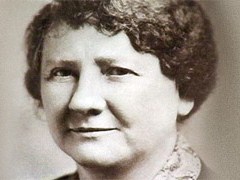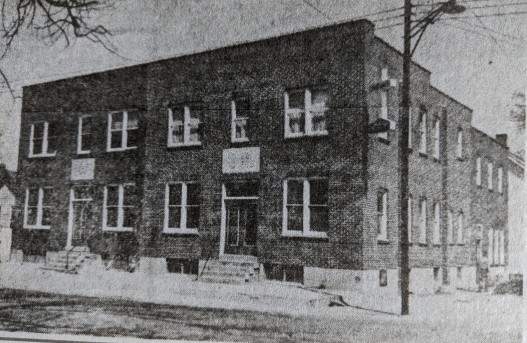We’re living during a global pandemic. Coronavirus, COVID-19, social distancing, ventilators, fatalities . . . these are all terms we have become too familiar with. At the same time, though, we’re hearing about extraordinary acts of courage and compassion, by healthcare workers, grocery clerks, delivery drivers and “people in the neighborhood” who see a need and work to fill it.
I have been thinking about some of the humble givers in my family tree, people who sacrificed so that others could live more full lives, or even just live. I’ll tell you about one of them today, my fourth cousin twice removed.
 Milton Fountain Boulware (fondly known as “Miss Mitt”) was born in Daviess County, Kentucky, in 1881, the middle of five daughters. Perhaps her father, Clarence Kellar Boulware, had been hoping for a son, or perhaps he just wanted to honor his brother who bore the same name. According to The History of Daviess County, Clarence “followed farming exclusively till 1880, when he erected a distillery on his farm. He makes about 1,000 barrels of sour-mash whisky, and 100 barrels of apple and peach brandy per year. He has a trade of 500 or 600 barrels yearly in Owensboro, besides a large trade in Michigan and other States.”
Milton Fountain Boulware (fondly known as “Miss Mitt”) was born in Daviess County, Kentucky, in 1881, the middle of five daughters. Perhaps her father, Clarence Kellar Boulware, had been hoping for a son, or perhaps he just wanted to honor his brother who bore the same name. According to The History of Daviess County, Clarence “followed farming exclusively till 1880, when he erected a distillery on his farm. He makes about 1,000 barrels of sour-mash whisky, and 100 barrels of apple and peach brandy per year. He has a trade of 500 or 600 barrels yearly in Owensboro, besides a large trade in Michigan and other States.”
His hard work and success, however, were no match for typhoid fever, and the family, like many others in those years, was left without its father and provider in October of 1889. He died at the age of 40, about three weeks before the birth of his youngest daughter.
Typhoid fever was taking the lives of hundreds throughout the state (and country). The Louisville Courier-Journal often carried articles about the “typhoid fever epidemic.” On December 3, 1889, they wrote, “Within three squares in the region of Vine street there are twenty-seven serious cases, and since last Wednesday five deaths have been reported at the Health Office.”
So Miss Mitt’s early years exposed her to sorrow and hardship and likely kindled the desire to help others in similar circumstances. Her mother, Jessie Barbour Boulware, lived until 1920, and her obituary noted that she was a member of the Pleasant Grove Presbyterian church “and a devout Christian.” She no doubt had a great influence on her daughter’s life, as did another strong woman, Jane Addams.
Miss Mitt received an education at the Owensboro Female College, Western Kentucky Teachers College, and the Moody Bible Institute in Chicago. While in Chicago, she worked beside social work founder Jane Addams at the famous Hull House in Chicago. History.com describes Jane Addams (1860-1935) as “a peace activist and a leader of the settlement house movement in America. As one of the most distinguished of the first generation of college-educated women, she rejected marriage and motherhood in favor of a lifetime commitment to the poor and social reform.” She was awarded the Nobel Peace Prize in 1931, the first American woman to receive this honor.
Miss Mitt taught school in Owensboro and Daviess County for 50 years, no doubt influencing hundreds of students in her classrooms during that time. But that was not enough for Miss Mitt, who clearly was following in Jane Addams’ footsteps.
In 1921 she was teaching at the Seventh Street School in Owensboro, in an area known as Porter’s Corner, described by a 1961 article in the Owensboro Messenger-Inquirer as “a real trouble spot where it was not unusual to see 13-year-olds drunk; where there were killings, and a reporter of the day said he never closed his notebook at night until he had checked Porter’s Corner.”
Miss Mitt, two other faculty members, and Miss Mitt’s sister Erma, who had been a city school truancy officer, conceived the idea of a mission in the neighborhood as a way to cut down on juvenile delinquency and be a cultural and religious influence in the inner city. They sought help from the churches in town, and the Christian Men’s League gave them $1,500 to start the project; an additional $1,000 contributed by businesses and civic-minded residents got them the $2,500 they needed to get started. On May 23, 1921, the Gospel Center Mission opened on the corner of Hall and Eighth Streets. Nine months later it was incorporated — and the organization still exists today, nearly a century later.
Miss Mitt was the driving force behind the Gospel Center Mission. At the same time that she was teaching school five days a week, she was envisioning a whole range of activities at the mission and garnering the support of other organizations to make those dreams come true. One friend said of her, “I am more and more convinced that one woman with the love of God in her heart and a vision of a better world can do far more toward revolutionizing that world than all the sources of nuclear energy.” What she achieved even in the early years of the Mission staggers the mind and would be the envy of many churches these days:
- Monday through Friday mornings, kindergarten
- Monday afternoon Girl Scout and Brownie troops
- Monday night prayer meeting
- Tuesday afternoon Homemakers class
- Wednesday afternoon Boys Club
- Thursday afternoon free piano lessons
- Thursday night Young People’s program, singing and devotions
- Sunday afternoon Sunday school classes
- Sunday night prayer meeting
What about Saturdays? That was Miss Mitt’s day to “go visiting,” calling on the sick and the needy. She traveled by bus from her home on East 21st Street down to the Hall Street neighborhood, taking along clothes and food and encouragement, sometimes twice a day.
During the Great Depression, there were many who struggled with despair and needed encouragement. Miss Mitt’s own namesake uncle slashed his throat with a razor in 1925. Men hopped passing railroad cars looking across the nation for work and often stopped in at the Gospel Center Mission for a meal and a place to sleep. A soup kitchen at the mission fed as many as 300 people a day.
Miss Mitt was never without an idea for helping the downtrodden and constantly appealed for funds from the community while also using her salary to sustain and expand the mission, in both outreach and construction.

Gospel Center Mission, 1956
Additions to the building gave it 32 rooms. A full service nursery school was established in 1959 with the help of the Pilot Club. Funding from the United Way supported after-school child care, adult education classes, senior citizens’ programs and more. By the early 1970’s, more than 1,000 people participated each month in the activities provided at the Mission.
Miss Mitt retired from teaching in 1951 and after that gave the Mission her undivided attention. On the occasion of her 82nd birthday in 1963, the Board of Directors voted to rename the Mission after her. In the early 1990’s, the Boulware Mission served exclusively as a homeless shelter. Life skills classes were incorporated and a drug and alcohol addiction treatment program was introduced in 2005. The Mission outgrew its Hall Street facility, and the board voted to purchase the vacant Passionist Nun Convent at 609 Wing Avenue. A $500,000 renovation of the building was conducted and in November of 2008, the Wing Avenue campus was formally opened with beds for 31 male clients.
Boulware Mission, 2020
Milton Fountain Boulware, “the Jane Addams of Owensboro,” passed to her reward on September 23, 1970. That day of September, the first day of autumn, happens to be my birthday.
Sharon I hope this finds you well. I just wanted to let you know how much I enjoy your postings. Thanks for including me. Dorothy
LikeLike
I’m glad you enjoy the stories. I think it’s fascinating — and inspiring — to read about people connected to us, even distantly.
LikeLike